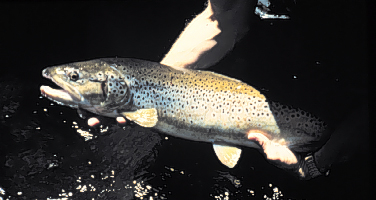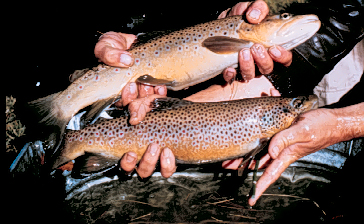Brown trout (Salmo trutta) are native to Eurasia, from Northern
Africa and westward throughout Europe and into Iceland and the British
Isles. They were introduced in to United States waters in 1883 and
are now widely distributed.
 The
diet of the brown trout consists of aquatic insects (primarily mayflies,
stoneflies, and caddisflies), fish, and crustaceans. Brown trout
forage actively at night. Small brown trout in lakes may feed heavily
on zooplankton, switching to insects, and then finally to fish later in
life.
The
diet of the brown trout consists of aquatic insects (primarily mayflies,
stoneflies, and caddisflies), fish, and crustaceans. Brown trout
forage actively at night. Small brown trout in lakes may feed heavily
on zooplankton, switching to insects, and then finally to fish later in
life.
Brown trout utilize specific stations within streams, and don't generally
move to other sections of the stream unless to spawn.
Brown trout typically return to natal streams to spawn. They will move
upstream during the fall, where the females will build nests (redds) in
gravel. After spawning, the redd is left unguarded. The suitability
of spawning environment depends on substrate, water velocity, temperature,
and dissolved oxygen conditions. Sedimentation can decrease flow
of water (and hence delivery of oxygen) to embryos in the redd.
Trout are generally found in coldwater streams characterized by riffle-pool
sequences, gravel or cobble substrates, and stable annual flows.
Instream cover (vegetation, woody debris, etc.) is important, as well.
Relative to some other species of trout (i.e. brook trout (Salvelinue
fontinalis)), brown trout can tolerate areas of higher temperatures.
The optimal temperature range for brown trout is 12 to 19 degrees Celcius,
with a temperature tolerance range of 0 to 27 degrees C.